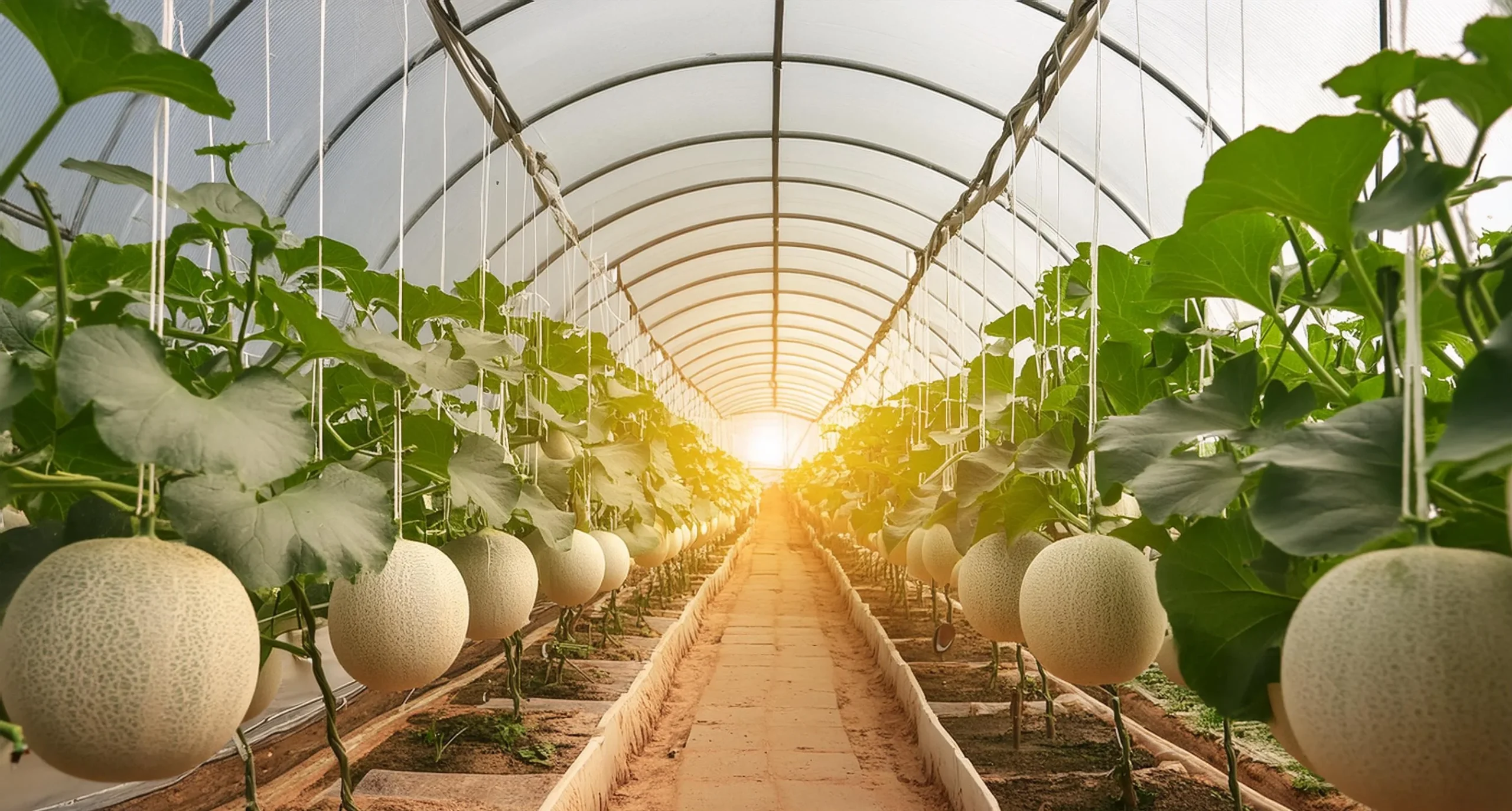When summer heats up, there’s nothing quite like biting into a homegrown melon. Farmer Briana Yablonski shares how to grow honeydews from seed to harvest.
Honeydew might not be everyone’s first pick when it comes to melons, but don’t dismiss them just because you’ve only had store-bought versions in fruit salads. A homegrown honeydew is refreshingly juicy with a delicate floral taste, holding its own against favorites like watermelon and cantaloupe.
These melons thrive in warm, sunny climates with plenty of room to sprawl. But even cooler regions can enjoy them with some planning. This guide covers everything—from planting seeds to harvesting ripe fruit.
Honeydew Melon ‘Cucumis melo’ Overview
Three smooth, pale green melons—one cut open to show light green flesh and clustered seeds—sit on a wooden table.
- Plant Type: Annual
- Family: Cucurbitaceae
- Genus: Cucumis
- Species: melo
- Native Area: Africa and Asia
- Exposure: Full sun
- Height: 1 foot (up to 8 feet if trellised)
- Watering Requirements: Moderate
- Pests & Diseases: Cucumber beetle, aphids, powdery mildew, downy mildew, bacterial wilt
- Maintenance: Low to moderate
- Soil Type: Rich and well-draining
- Hardiness Zone: 2-11
What Are Honeydew Melons?

They are smooth-skinned muskmelons with pale flesh and trailing vines but no musky scent
Honeydews are smooth-skinned muskmelons with pale flesh and trailing vines—but no musky scent. Unlike cantaloupes, they don’t emit a strong aroma when ripe (hence the name “inodorus,” meaning “without scent”). They also don’t ripen further after picking, so timing matters for peak flavor.
While the classic green-fleshed honeydew is most familiar, many cultivars exist with varying skin colors and flavors. All belong to the Cucumis melo species, which includes cantaloupes and crenshaw melons.
Characteristics

They have waxy green to yellow skin and light green, orange, or white flesh.
- Skin: Waxy, pale green to golden yellow
- Flesh: Light green, orange, or white
- Size: Typically 5–10 pounds at maturity
The plants produce long, sprawling vines with yellow flowers that develop into melons after pollination.
Native Area

They originated in Africa and Asia, reaching Europe and America through centuries of cultivation and trade.
Historians believe melons originated in Africa and Southwest Asia, with honeydews evolving through centuries of cultivation. They spread to Europe and the Americas via trade, becoming popular in the U.S. by the early 1900s.
Planting

Plant them after frost, but early enough for them to ripen before cooler fall temperatures.
Honeydews need about three months to mature, so plant them early enough to ripen before fall’s cooler temps. But since they hate cold, wait until after the last spring frost.
You can direct-sow seeds or transplant seedlings—choose based on your climate and preference.
Starting Seeds Indoors

Start seeds indoors in large trays one to three weeks before your area’s last spring frost.
In short-season areas, starting seeds indoors boosts the chance of harvest before frost. Even in warm climates, you can start seeds inside—though it’s optional.
- Sow seeds 1–3 weeks before your last frost date in large cell trays or pots (small containers stunt growth).
- Plant 1–2 seeds per cell, ½ inch deep.
- Keep soil at 70–85°F (21–29°C) for quick germination (a heat mat helps).
- Once sprouted, provide 12–14 hours of light daily (grow lights work if sunlight is scarce).
- Thin to one seedling per cell after true leaves appear.
- Harden off seedlings before transplanting outdoors.
Direct Sowing

In warm climates, sow directly outdoors when the soil warms above 65°F and nights stay above 50°F.
In warm climates, sow outdoors once:
- Soil reaches 65°F (18°C).
- Nights stay above 50°F (10°C).
Plant 2–3 seeds per hole, spaced 2 feet apart (vines spread!). Thin to the strongest seedling after germination.
How to Grow

They need full sun, warmth, and fertile soil for healthy growth from seed to fruit.
Honeydews need full sun, warmth, and fertile soil to thrive.
Light
- 8–10 hours of direct sun daily. Less light = weak flowering + disease risk.
Water
- Young plants: Keep soil evenly moist.
- Mature vines: Water deeply 1 inch twice weekly.
- Ripening fruits: Reduce watering to boost sweetness and prevent splitting.
- Avoid wet leaves (drip irrigation or base watering is best).
Soil
- Well-draining, pH 6.0–7.0.
- Amend with compost for fertility and structure.
Temperature & Humidity
- Ideal temps: 75–90°F (24–32°C).
- Cold slows growth below 60°F (16°C); frost kills seedlings.
- High humidity increases fungal risk—space plants for airflow.
Fertilizing
- At planting: Use balanced fertilizer or compost.
- Avoid excess nitrogen after flowering (promotes leaves, not fruit).
Maintenance
- Trellising: Optional but helpful. Use sturdy supports (wood/metal).
- Train vines gently; use pantyhose or nets to support heavy fruits.
Harvesting & Storage
Ripe honeydews:
- Turn creamy yellow (from pale green).
- Have a soft blossom end.
- Feel heavy for their size.
Harvest by cutting or gentle tugging. Unlike other melons, they won’t ripen further off the vine.
Storage:
- Whole: Fridge for up to 2 weeks.
- Cut: Sealed in fridge for 2–3 days.
Common Problems
Honeydews share pests/diseases with squash and cucumbers. Watch for:
Aphids
- Sap-sucking insects that weaken plants.
- Control with ladybugs, lacewings, or insecticidal soap.
Cucumber Beetles
- Chew leaves and spread bacterial wilt.
- Protect seedlings with row covers; spray neem oil if needed.
Powdery Mildew
- Fungal disease from humidity.
- Improve airflow; avoid wet leaves.
Downy Mildew
- Yellow/brown patches on leaves.
- Prevent by watering soil (not leaves) and planting in sunny spots.
Bacterial Wilt
- No cure. Vines collapse suddenly.
- Spread by cucumber beetles—control pests early.

